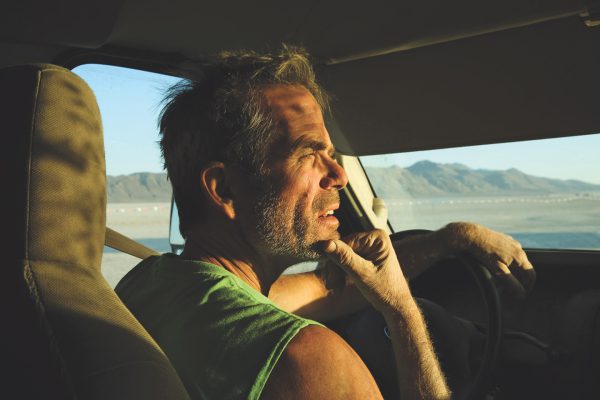
By Billy Fried
You know that saying about not realizing how good something is until it’s gone? I fear that could be the case with our little radio station, KXFN (104.7 on your FM dial). You know, the one that’s been broadcasting for over a decade now. It’s a miracle our micro market of 22,000 residents can sustain live, terrestrial radio – let alone two weekly newspapers and a monthly magazine. It speaks volumes to our community’s interest in public affairs and residential real estate advertising.
KXFM was like a lightning bolt that struck from the heavens when 24-year-old Tyler Russell launched the venture. It was a heady time for Laguna, as a large swath of locals lined up to volunteer their time – myself included. Hey, we like the sound of our voices in Laguna. And that’s a feast for all you introverts at home.
And just like that, we launched with a full spectrum of eclectic programming – at least from the volunteers at night and on weekends. Like the one on Canadian music, which seemed to me as plausible as, say, Canadian cuisine. But Earle Jive showed me I was wrong. And that’s the beauty of independent radio, programmed and curated by real people – that sense of discovery. The station also featured new age and self-help shows, shows on South African, Reggae, and Hawaiian music, rockabilly from the great Lee Rocker (of Stray Cats fame), live music in studio from music lover Rick Conkey, and the irrepressible “Ida Mae” (Cindy Obrand), delighting us with her Saturday roadside rhapsodies on alt country and bluegrass.
Plus, our mornings perked up with the delightfully snarky and unpredictable musings of Jason Feddy. We knew him as a gifted musician and songwriter, but had no idea how twisted his mind was. He’s entertaining, insightful and nakedly honest, and he represents the best of Laguna.
But, alas, it’s hard to continually sell advertising on a station so small it has no ratings. And when the initial euphoria wore off, things plateaued. And then there was Covid, cutbacks, and ultimately a lack of resources to pursue the Sisyphean task of ongoing non-profit fundraising.
But what if the model is wrong? Why are we asking merchants to fund the station when the true beneficiaries are the listeners?
Simply stated, the station is indispensable to our safety. For every resident (and visitor as well), the station is a critical lifeline during an emergency or mass evacuation. Electricity, internet and cell phone communication can go dark in an instant. But not a radio station with back-up generators, with a pipeline to police and other emergency officials. Would you pay just $10 a month ($120 per year) for a resource that, while it may not reimburse you for that entertainment center, could save your life? What if Paradise, Calif., had had a local radio station? Could any of those people who got incinerated in their cars been diverted?
Every household and hotel room should have a hand-crank or battery-powered radio for when the grid goes down. For that reason alone, the city should provide a considerable subsidy from its emergency preparedness budget. And the rest of the burden should be borne by our community.
The real reason for the station’s faltering fortunes is not the business model, but the execution. Those young founders never understood our demographic. “Generational Alt Rock?” What’s that? And when they switched to “Human Crafted Radio,” it sounded more like baked goods. Two key words were always missing that should have been their guiding principle: “Laguna,” and “Community.” Because that’s what a hyper local radio station can offer that truly differentiates it in a saturated, algorithmic-led media world.
Besides emergency broadcasting capabilities, there’s plenty of day-to-day content that would be well worth paying for. Radio is a special medium. It still delivers the best in long-form discourse, live and up-to-the-minute news, and immediacy and insights from its thoughtful personalities. What if we had a potent lineup of local news, politics, arts, culture, education, weather, high school sports, and live, event-based broadcasts? All rounded out with more sophisticated music that appeals to our older, educated residents. Like jazz, opera, classical, classic rock, R&B, and ethnic and niche music from around the globe. And of course a show dedicated to our own vibrant music scene.
We’ve got the talented personnel and radio savants who passionately want to keep the station going. We have the incredible gift of an FCC license that would be criminal to squander. We just need some benevolent philanthropists who love Laguna to step in and make a tax-deductible legacy donation to buy the station and staff it with some full-time professionals. There’s additional funding sources out there like grants and sponsorships. It’s not an expensive proposition, as non-profits cannot sell for a profit.
Who will step up and enable our glorious local radio station, a future that can showcase the best of Laguna, and keep us safe? If you are interested in seeing this resource continue, feel free to contact me, and I will fill you in on the details.
So please stay tuned… hopefully to KXFM, Laguna’s Community Radio.
Billy is the CEO of La Vida Laguna, an outdoor adventure company, and the host of “Laguna Talks” on KXFM radio – Thursdays at 8 p.m. Email: [email protected].





In addition to being a Laguna Beach resident, I am the founder and executive producer of http://www.themellowsound.net, heard also at http://www.knxfm93.com.
We are a streaming service that recreates the classic mellow rock format which made KNX • FM 93 in Los Angeles the best of its genre. We are smart enough to know who our demographic is, and program only the songs from core mellow rock artists like James Taylor, Eagles, Janis Ian, Carly Simon, Steely Dan and others. If you tune us in you will hear many of these artists (and more!) introducing their songs because they are fully engaged in our mission of streaming over 2,700 songs played authentically on KNX • FM 93 from 1973 through 1983.
While we should embrace local programming like that heard for many years on KXFM, its Low Power FM (LPFM) frequency is technically problematic due to its limits of broadcasting range complicated by the low power and terrain of our area. It’s simply not financially feasible to require a transmitter and maintenance, licensing costs, studios, space, broadcasting talent and promotional efforts. I believe these are the issues which have created the current problems…but they have apparently been long in coming due to a business plan which failed to recognize and adjust for them.
Yes…while the need for local safety information is critical in an emergency, few people will likely actually rely on LPFM broadcasters due to the simple lack of familiarity with these resources, including KXFM. They will tune instead to the larger (more professional?) media outlets for needed emergency information.
The station should carefully consider going to a streaming-only service to address its financial challenges by leaving behind the old transmitter and space model. A closet-sized studio is all that is required for programming of either live or pre-recorded content. While not live, our stream is curated by talent in all parts of Southern California, and our servers are managed by a programming / software consultant in Hong Kong.
I suggest you tune in to see what’s possible for what I believe would be an operating cost basis of less than five percent (5%) of what KXFM now costs its operators — and its benefactors — who seem to have recognized this new technical reality.
One thing I have learned as a former news anchorman, radio host, and now broadcasting entrepreneur: It is NEVER about how the content is delivered. It is ONLY about the content.
Thanks for sharing YOUR opinion of the value of local audio content.
Thanks Billy, for your great article about KXFM. You really captured the spirit and essence of community radio. Our local station touches people in a powerful and magical way. I’m inspired to preserve some of the adventure, the wonder and the power of grassroots radio. That is my vision of true Community Radio, a rare medium, well done. Your article gives me hope that our little station will survive and thrive with the financial help of local residents and city government.
I want to give a special thanks to local DJ, John Ford, for keeping us all live on the air during this difficult transition. Let’s gather together and rally for radio. I am all in.
Patrick, thanks for your analysis. What “larger media outlets for emergency information” would you recommend for us that will have boots on the ground?
Cindy, you are a big part of radio magic!
Thank you Billy, for the spotlight on our local radio station – we are in a difficult transition, and as we make our way through, we will be needing the support from the community that we are proud to serve.
Thank you Patrick, for YOUR opinion of local audio content – I’m glad you had the opportunity to give a shoutout to your streaming service, which I have listened to, and as I have told you many times before, is a cool idea – I used to listen to KNX all the time back in the day.
However, you really missed the mark on LPFM stations by highlighting their technical limitations rather than the way they actually serve their purpose as *community oriented* resources – they are not meant to reach a large audience, or interfere with larger commercial broadcast entities. The LPFM model was conceived by the FCC for that express purpose. They *can* reach larger audiences by streaming content, which KX does, in addition to over the air broadcast. We have a large and loyal listenership, thank you very much.
In reality, the local listener has no real concept of whether we’re a low power station or not, nor should they care. What should be important is whether or not they can get information at critical times, when other forms of communication infrastructure are unavailable. A good working relationship with the city government makes it possible for first responders and others with the needed info to have an outlet. Wind-up transistor radios should be available to all that don’t have a new-fangled EV to power their TV for a couple hours… and you know as well as I that larger (more professional? really Patrick?) outlets will not have information with the immediacy needed in a local crisis.
It’s true, the cost structure of a bonafide radio outlet can not match the economy of a closet streaming service. But again, the community aspect of KXFM includes giving volunteer members of the community the opportunity to present diverse content to *our* community, 24/7 – this is the unique value of KXFM, today, and hopefully well into the future.
John:
My intent in mentioning my streaming enterprise was not promotion, but to qualify my experience and to support my position on the cost-versus-benefit of operating a true broadcast operation like that of KXFM.
In its many years of operation, how many times has the station been the sole or primary source of local information during an emergency? In addition, how many listeners tune in via the LPFM frequency and its limited range, rather than by KXFM’s “Listen Live” feature on its web site, or via TuneIn and / or other streaming apps?
If my household of two residents in their sixties is any indication, there’s a single 1980s-era Sony “Dream Machine” clock radio that is never used to listen to FM programming. All broadcast content is streamed via Smart TV, the web, or AWS smart speakers. I imagine that the younger the average age of a home’s residents, the less likely there is to be a radio even present in that home.
My only intent with my reply was to ponder the economic realities of Billie’s plea for the community to donate funds to maintain operations as they currently run. (Thanks for your stellar efforts in keeping the enterprise running and sounding great, BTW!) As technologies change, so, too, should listener expectations and operators’ content delivery strategies.
A recent example is the fact that the LA Times will no longer deliver a printed newspaper to my Laguna Beach home for less than $20 weekly. As a result, they have forced me to go to a digital delivery model which my wife cannot stand. She finally agreed that a subscription cost of over $1,000 yearly makes no economic sense, because that’s what they need to pay the drivers to get me their printed content! So, the only reason the LA Times has priced it at that amount is to force its readers to change their habits.
Perhaps KXFM leadership should carefully consider forcing its listeners to change theirs, so that the terrific local content and neighborly culture can continue under less economic pressure. There was business news only today that Audacy, with 250-plus commercial stations in the US, will likely declare bankruptcy soon because of their stubborn commitment to transmitters and denial of the impacts of these new technologies on their business model. So, this is not about a failure of KXFM. This is simply about economies of scale and a cost-benefit strategy seen as inevitable and demonstrated by other media outlets.
I stand by my my contention that your listeners care more about the excellent local content and culture of KXFM’s program than how both are delivered into their homes. I hope my comments are received by you and others as they are intended.
Patrick,
I’m happy to answer that question. The station has provided emergency broadcast info a number of times. Once there was a fire in the canyon, blocking Laguna Canyon Rd. I was near the station and went in and manned the mic. Mayor Bob Whalen was on the scene and phoned in with emergency officials with regular updates. When we had the recent fire near Emerald Bay, again the station was broadcasting regular updates, which was vital to the residents of that community as they were on hyper alert for possible evacuation. I’m sure there are other examples.
We don’t know how many people listen to the radio versus the app, but if the electrical grid goes down, or the phone lines, the streaming apps are of no use. And if just one life is saved because of a radio broadcast, isn’t that enough to justify the spend of the city to support this?
You may be right about the lack of battery-powered or hand crank radios in Laguna, which simply means there should be an ongoing marketing campaign to convey the importance of having one. Every hotel room should provide one, because most visitors would never know how to find our station online. And for the many people traveling by car, terrestrial radio is still the best option. It’s how I listen to the station, and I am in your demographic.
I also subscribe to the paper version of the LA Times. But newspaper economic models are a false equivalency to radio, because radio delivery is free. But one problem they share is the drift of advertisers to the web, and this has unfortunately devalued real journalism and local content, which are both vital in these times of misinformation.
I believe there is still a place for local, community driven radio that can add vitality and cohesiveness to our town. And that it is well worth paying for.
Where were you Billy when the City staff with supporters on the City Council were trying to give an upstart bully $35K to do podcasts of the mayor’s talk and emergency notification ability? I was there actually arguing for the radio station that has received tens of thousands of taxpayer money to continue with that service. I have not been a fan of the radio station because of their one sided political bias and slavish support for city leadership and their actions without questions. Amazing how the city turned it’s benevolence to an unproven newbie with no listenership.
Michelle Monda: never one to squander an opportunity to turn a rare moment of agreement into a whiny screed on how bad everyone and everything is.
Billy:
Our operation is likely less sophisticated than that of KXFM, and we receive weekly and monthly reports which track listener IP addresses and locations, plus new and returning listener counts and total listening hours. That KXFM either will not answer this question, or has not invoked such reporting functions to track these metrics, is an operating issue. How can the station justify asking for more money to support an ageing business model without defending that request from this perspective in a fast-changing media delivery environment?
Much audio programming is certainly DELIVERED free (unlike newspapers) but the issue here, in my opinion, is the TOTAL cost of the operation, including all of those I outlined above. To suggest all media are not struggling to redesign themselves is simply not true. Look at the low cost of entry and operations enjoyed by KXFM’s newest local audio competitor. (I agree the competing audio programming is NOT at all interesting or comparable.)
Finally, John Ford is coincidentally my former next door neighbor and knows how to reach me. We three could meet for a beer and a discussion rather than have it here.
Otherwise I wish only the best success for KXFM and your effort to shore it up financially.
Thanks.
Patrick,
Of course KXFM knows their streaming audience. That’s the easy part.
As I stated in my column, the reason why KXFM doesn’t have terrestrial listener ratings is they’re too small to qualify for Arbitron. Or it’s too expensive. And that’s why I believe that sponsor sales are ultimately difficult to sustain, and are mostly predicated on goodwill and the branding the station offers in its grass roots and fundraising events. That’s why the “ageing business model” is ripe for disruption. All the streamers recognize that people will pay $10/mo for advertiser-free content. It’s all about the value of the content. And I still believe there’s a place for local, community-based content – something streamers can’t provide.
Sure, let’s gather online. I have a few other stakeholders interested.
Billy:
“…I still believe there’s a place for local, community-based content – something streamers can’t provide.”
Unless KXFM switches to a stream-only delivery with the same great local content at a fraction of the operating cost. Which has been my point all along.
Be in touch and thanks.